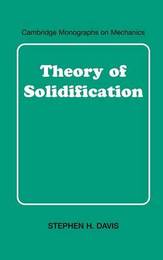
|
Theory of Solidification
Hardback
Main Details
Description
The processes of freezing and melting were present at the beginnings of the Earth and continue to dominate the natural and industrial worlds. The solidification of a liquid or the melting of a solid involves a complex interplay of many physical effects. This book presents in a systematic way the field of continuum solidification theory based on instability phenomena. An understanding of the physics is developed by using examples of increasing complexity with the object of creating a deep physical insight applicable to more complex problems. Applied mathematicians, engineers, physicists, and materials scientists will all find this volume of interest.
Reviews'The reviewer strongly recommends this book for those who want to start their research ... also be recommended as a text-book at post-graduate level ... hence the real importance of this book.' Zentralblatt fur Mathematik '... an authoritative handbook for the dedicated specialist, and as such a valuable addition to any library of materials science and engineering or applied mathematics.' D. Weaire, Contemporary Physics 'This book gives an excellent overview of the main areas of solidification theory, with emphases that reflect the interests and background of the author. For a reader with an applied math background and a strong interest in weakly nonlinear techniques, it is a good way into the field without getting lost in materials science arcana.' SIAM Review 'The monograph is highly recommended to all applied mathematicians, engineers, and physicists working in the field of phase transformations.' ZAMM
|